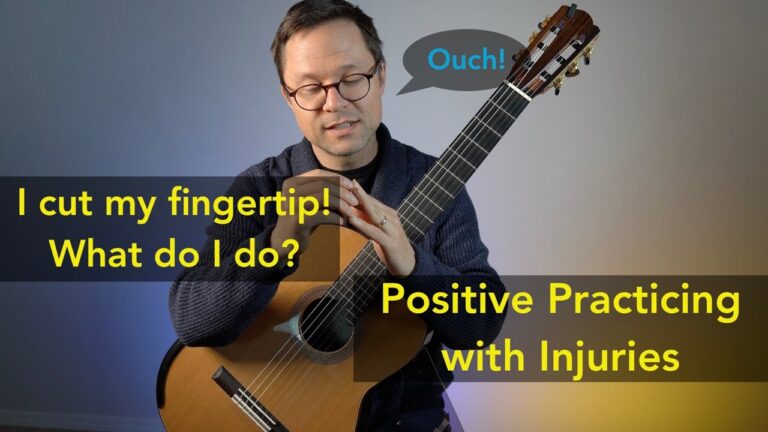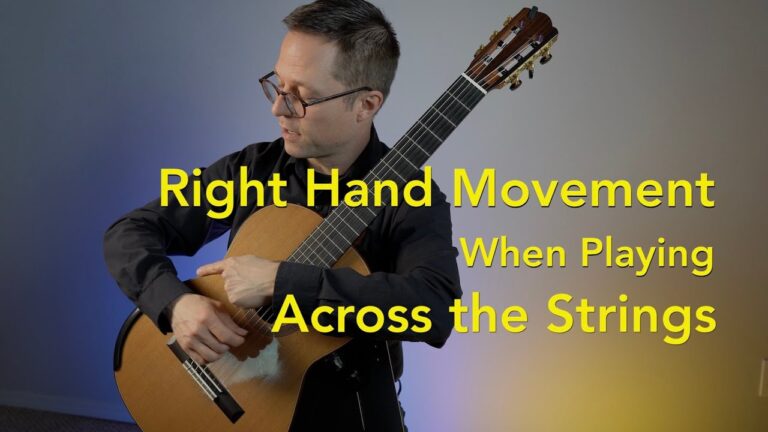How to Play Legato on Classical Guitar – In this lesson I divide up the elements of how to play legato on guitar into five main sections:
- Legato Listening Skills (Psychological)
- Right Hand Legato
- Left Hand Legato
- Synchronization of Both Hands
- Sound Production and Room Acoustics
A definition via this Wiki: “In music performance and notation, legato (Italian for “tied together”) indicates that musical notes are played or sung smoothly and connected. That is, the player makes a transition from note to note with no intervening silence. Legato technique is required for slurred performance, but unlike slurring (as that term is interpreted for some instruments), legato does not forbid re-articulation” [re-articulation: plucking each note on guitar]
Legato Listening Skills (Psychological) – Legato is a smooth and connected sound. But that doesn’t mean much unless you contrast it with something. Therefore, when I teach beginner students I have them play legato and staccato to understand the contrast. Legato is smooth and connected, staccato is cut short and disconnected. Becoming ultra aware of your legato and staccato articulation is key to correcting it whenever you hear yourself play. Also, you may wish to appreciate legato phrasing in other instruments besides guitar, voice, string instruments (cello, viola, violin), woodwinds, all produce excellent legato phrasing. Orchestras might be the ultimate legato sound with so many instruments all contributing to continuous sound within a phrase. Train your ear to hear high quality legato from professional players and your body will try to create it in your own playing.
Right Hand Legato – When the right hand touches a vibrating string it stops the sound. Therefore, in order to play legato the right hand finger that is plucking the string must spend as little time on the string as possible. Beginner students and performers in big halls must balance this fact with solid sound production and string contact. Nevertheless, a stroke that passes through the string without delay is key to legato playing. Practicing legato and staccato phrasing on a single open string is an excellent way to contrast the two articulations.
Left Hand Legato – Sustaining a note (holding your finger down) until to hear the next note is essential to legato playing. We must hear the next note before lifting any finger. In addition to holding notes we must be sure to not place a finger too soon before the right hand plucks it or it might mute a vibrating string (connected to synchronization).
Synchronization of Both Hands – Since both hands can mute a vibrating string by touching it, we must make sure to move both hands/fingers into position at the same time. If we don’t synchronize our movements, one of the hands might prematurely mute a string before the other hand can complete the connected motion.
Sound Production and Room Acoustics – The guitar has a resonating body and if that body is resonating and producing lots of sound it creates a cushion of sound that will allow legato or the illusion of legato to occur. This is connected to the resonating sound of the room acoustics as well. Playing in a small carpeted room compared to a large reflective church or performance hall will completely change the perceived legato sound. However, we can not rely on room acoustics or reverb in recording programs. In the end, we are only as legato as we sound in the most acoustically dead room.
Playing legato is a life-long endeavour so give it time while practicing each element separately. By the time you have made some good progress on each of the above elements you’ll probably be playing pretty legato. Remember to sing and challenge yourself to new levels of legato playing. Compare yourself to a cello or singer instead of a guitarist. Aim high and get high quality legato into your ears.
Educational Book Series
- See my page on How to Use my Educational Series.
- Classical Guitar Method – Vol. 1, Video Lessons, 100 pages, Free PDF
- Classical Guitar Method Vol. 2, Video Lessons, 89 pages.
- Classical Guitar Repertoire Lessons Grade 1 – Dedicated lessons for each piece.
- Classical Guitar Repertoire Lessons Grade 2
- Classical Guitar Repertoire Lessons Grade 3
- Classical Guitar Repertoire Lessons Grade 4
- Classical Guitar Repertoire Lessons Grade 5 – Coming December 2020
- Classical Guitar Technique: Essential Exercises, Scales, & Arpeggios – 122 pages, Video lessons. Start anytime after Vol.2 method and continue with repertoire lessons.





Appreciate you, Bradford. Thank you!
-Verne Varona
Thank you for all the good advice!
Grateful you’re there doing what you’re doing. Thank you!
Very useful. Thanks.